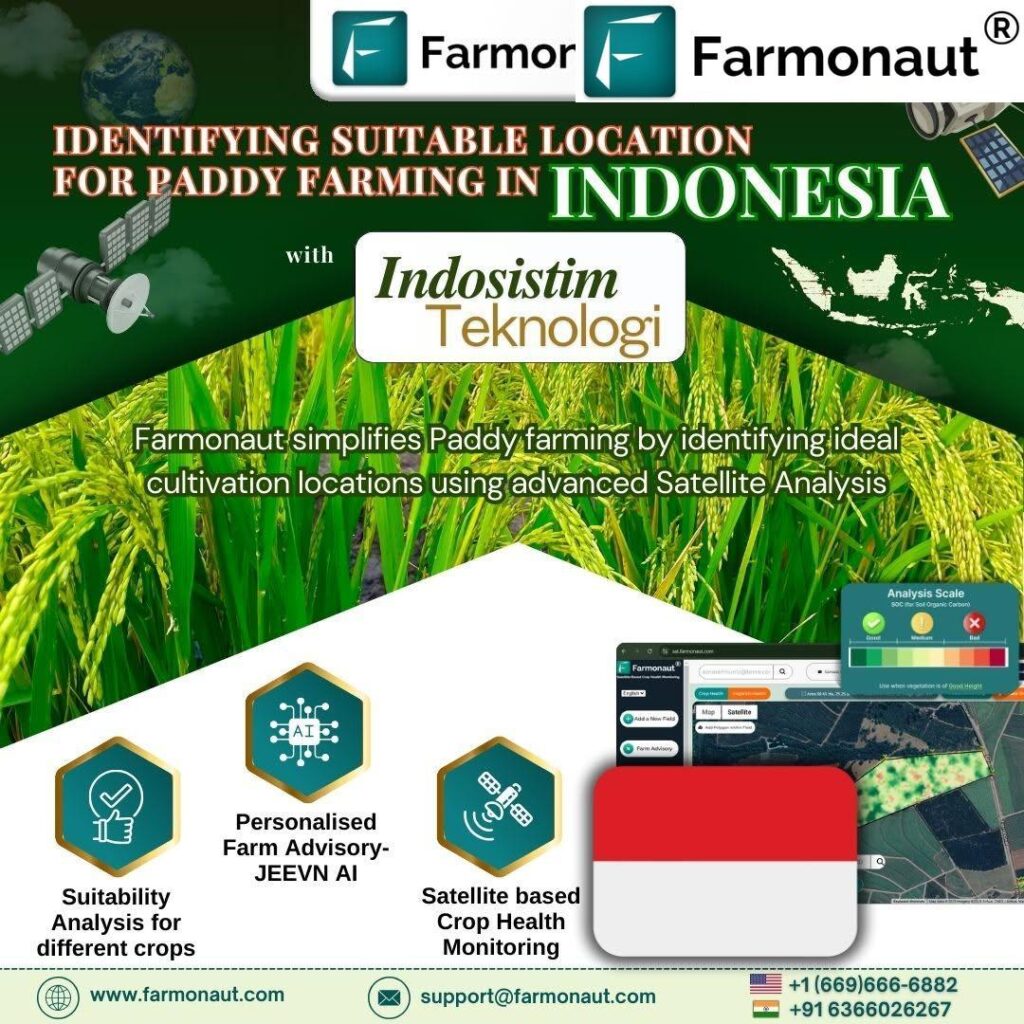Emerging Trends in Agribusiness India 2025 Insights: Digital Innovation, Sustainability, and Policy Shifts That Are Reshaping Indian Agriculture
“By 2025, over 60% of Indian agribusinesses are expected to adopt digital platforms for supply chain management.”
Table of Contents
- Introduction: Indian Agribusiness Landscape in 2025
- Digital Agriculture & Precision Farming: Shaping the Future
- AgriTech Startups and the Indian Innovation Ecosystem
- Sustainable & Climate-Resilient Agriculture Models
- Mechanization and Farm Modernization Trends
- Value Addition & Agribusiness Diversification
- Policy Reforms and Institutional Support
- Rising Consumer Awareness & Quality Demands
- Satellite Technology: Farmonaut’s Role in Agribusiness Transformation
- Trends Comparison Table (2025)
- Frequently Asked Questions (FAQ)
- Conclusion: Transforming Indian Agriculture for 2025 and Beyond
Introduction: Indian Agribusiness Landscape in 2025
India’s agricultural sector remains a fundamental pillar of the economy, providing livelihood to nearly half the population. As we approach 2025, we observe that the agribusiness landscape is undergoing transformative changes driven by technological advancements, innovative models, policy reforms, and market dynamics.
These emerging trends in agribusiness and emerging agriculture trends India 2025 are shaping a new era—making Indian farming more sustainable, efficient, and profitable. As the world’s largest producer of spices, pulses, and milk, India’s agribusiness sector is not just vital for domestic food security but is also becoming a key player in global trade.
In this comprehensive analysis, we explore the trends in agribusiness for 2025 and beyond, spotlighting digital innovation, sustainable practices, and policy shifts that are redefining Indian agriculture and providing growth opportunities for farmers and agribusinesses nationwide.
Digital Agriculture & Precision Farming: Shaping the Future
Emerging Agriculture Trends India 2025: Precision Farming & Smart Technologies
One of the most significant emerging trends in agribusiness is the widespread adoption of digital agriculture and precision farming methods. Indian farmers are increasingly leveraging a suite of technologies that include:
- Satellite imagery and AI-powered analytics
- Drones for real-time monitoring and spraying tasks
- IoT sensors monitoring soil health, moisture, and weather conditions
- Big Data platforms for crop advisory and yield prediction
Modern digital tools and analytics enable precise monitoring of soil, crop conditions, water usage, and even pest infestations. By optimizing input usage—such as water, fertilizer, and pesticides—these technologies help maximize yields while minimizing environmental impact and reducing costs.
The Government of India’s initiatives—such as Digital India, soil health card schemes, and financial support for technology adoption—are accelerating this transformation. These developments make precision agriculture accessible to even small and marginal farmers, democratizing access to data-driven decision making.
Key Components of Digital & Precision Agriculture:
- Remote Sensing: Analyzing crops using satellite data for vegetation health and stress mapping
- Variable Rate Application: Precision application of fertilizers and irrigation using automated equipment
- Farm Management Platforms: End-to-end monitoring and advisory services via mobile/web apps
- Weather Analytics: Accurate weather updates and predictions for timely action
Platforms like Farmonaut are enabling real-time data-driven decision-making. We provide satellite-based crop health monitoring, AI-powered weather advisory, and actionable insights, supporting both individual farmers and agribusiness managers in operational efficiency.
The emerging trends in agriculture India 2025 clearly indicate that digital adoption—from farm-level soil health checks to AI-based pest advisories—will be crucial for Indian farmers and agribusinesses seeking to stay competitive and sustainable in 2025 and beyond.
Want to enhance your agribusiness platforms with advanced weather and crop insights? Explore Farmonaut’s Weather & Satellite API or review the API Developer Docs for seamless integration.
Agritech Startups and the Indian Innovation Ecosystem
Emerging Trends in Agribusiness: Startups, Platforms, and Digital Marketplaces
The rise of agritech startups is revolutionizing India’s agribusiness sector, catalyzing innovations across the value chain. The innovation ecosystem is empowering farmers by providing solutions for:
- Supply chain management (digitally tracking and optimizing movement of goods)
- Real-time farm advisory services and decision support
- Financial inclusion (agricultural credit scoring, satellite-based insurance verification)
- Market linkages and direct-to-consumer platforms
- Official e-NAM integration (National Agriculture Market) for pan-India market access
Powerful platforms now provide weather updates, AI-guided crop advisories, and blockchain-based traceability to empower farmers and agribusinesses with informed capabilities.
Tracing the Food Journey: Blockchain & Traceability
Solutions such as blockchain-based traceability are gaining importance for guaranteeing the quality and safety of agricultural produce. India’s Farmonaut’s Traceability System offers blockchain-powered transparency from farm to fork, allowing consumers and supply chain managers to verify origins, reduce fraud, and ensure premium food safety standards.
Farmonaut integrates blockchain with satellite observations to enable transparent, tamper-proof tracking of crops and products, creating trust across the agri-value chain.
- Contract farming, direct-from-farm models, and cold chain integration are also supported by digital tools.
The emerging trends in Indian agriculture 2025 show that technology is the backbone of innovation, fostering digitally integrated, transparent, and efficient agribusiness operations.
Managing vast operations? Get end-to-end visibility, crop mapping, and advanced analytics with Farmonaut’s Large Scale Farm Management tools.
Sustainable & Climate-Resilient Agriculture Models
Sustainable Practices: Key to Resilience for 2025 and Beyond
India’s agricultural sector is on the frontline of climate change—facing unpredictable rainfall patterns, rising temperatures, and extreme weather events. To safeguard farmer incomes and ensure food security, sustainable agriculture and climate-resilient practices are gaining emphasis as part of the core emerging trends in agribusiness.
“Sustainable agriculture practices in India are projected to grow at a CAGR of 12% through 2025 due to policy reforms.”
Key sustainable agriculture models and practices gaining ground in 2025 include:
- Organic farming, reducing chemical inputs and boosting soil health
- Water-efficient irrigation like drip and sprinkler systems, especially important for water-scarce regions
- Integrated Pest Management (IPM) for reducing pesticide usage and environmental load
- Use of bio-fertilizers and renewable energy (solar pumps, biogas)
- Climate-resilient crop varieties, including drought and flood-tolerant seeds
- Agroforestry as a means of diversification and ecosystem restoration
The Indian government and numerous NGOs are actively supporting these models. Farmonaut provides critical monitoring tools, such as carbon footprint tracking and environmental impact monitoring, which support compliance and the adoption of global sustainability standards.
Sustainable farming helps increase profitability and resilience for Indian farmers, preparing them for the market and climate challenges of 2025 and beyond.
Interested in optimizing multiple crops or plantation management? Farmonaut’s Plantation, Crop, and Forest Advisory delivers AI-backed strategies for efficient crop rotation and ecosystem health.
Mechanization and Farm Modernization Trends
Farm Mechanization: Modern Tools for Higher Productivity
Ongoing labor shortages, the need to reduce drudgery, and the drive to boost productivity are catalyzing mechanization and farm modernization across Indian rural landscapes. This is a vital part of emerging trends in agribusiness for 2025.
- Mini-tractors and power tillers for smallholdings
- Automated seed drills/machinery for timely sowing
- Drones for crop sowing, fertilization, spraying, and real-time crop health evaluation
- Automated harvesters and processing machines
- Telematics systems for fleet and equipment management
Intelligent fleet management, route optimization, and preventive maintenance are helping reduce operational downtime and costs. Farmonaut’s satellite-driven Fleet Management supports agribusinesses in tracking vehicles and machinery across extensive geographies more efficiently.
Major drivers for mechanization and modernization include the availability of:
– Affordable leasing schemes
– Government subsidies on machinery
– R&D towards miniaturized solutions for marginal farmers
With such innovations, Indian agriculture is witnessing the rapid rise of smart machinery, crucial for improving yields, reducing post-harvest losses, and supporting the transition to a technology-first approach in 2025.
Value Addition & Agribusiness Diversification
Farm-to-Fork Transformation: Moving Beyond Commodities
Indian agriculture is transitioning from commodity-based production to a more value-added and diversified agribusiness model. The emphasis is shifting towards:
- Food processing and packaging
- Supply chain cold storage infrastructure for perishables
- Direct farmer-to-customer models (farmgate-to-home)
- Allied sectors like dairy, poultry, fisheries, and agroforestry
- Contract farming supported by clear digital agreements and traceability
- Digital marketplace integration for price discovery and reach
This diversification is reducing dependence on a single crop or market and is opening up multiple income streams for rural India. With cold chain logistics and blockchain tracking, post-harvest losses are minimized and quality standards ensured, resulting in superior margins and export potential.
Emergence of agri-fintech solutions for crop loans and insurance has further empowered smallholder farmers, enabling access to working capital at scale.
Combined with evolving consumer preferences for organic produce and wellness foods, these emerging trends in agribusiness are shaping the future by meeting both market and sustainability goals.
Policy Reforms and Institutional Support
Government Schemes, Regulatory Changes & National Integration
The government has recognized the need for comprehensive reforms in the agricultural sector. Major changes and support models in 2025 include:
- PM-KISAN: Direct income support for farmers
- Soil Health Card: Personalized soil and input management
- MSP Enhancements: Improved Minimum Support Prices to ensure farmer returns
- Promotion of FPOs: Farmer Producer Organizations increase scale and bargaining power
- Integrated rural infrastructure: Roads, warehouses, and cold chains aligned to National Agriculture Market (e-NAM) vision
Such institutional frameworks are creating an ecosystem for equitable growth, incentivizing modernization, market integration, and the adoption of world-class standards in agribusiness.
For 2025, policy reforms are focused on enabling innovation, streamlining operations, and reducing intermediaries by boosting transparency through digitization and blockchain.
A strong institutional push is also being made for resource management, digital payments, direct benefit transfer, and improving market access for marginal farmers—key pillars in the emerging trends in Indian agriculture 2025.
Rising Consumer Awareness & Demands for Quality
Market Shift Towards Quality, Traceability, and Health
Indian consumers are becoming more aware of food origins, nutritional value, and quality certifications. Demands for traceability, organic produce, and safety standards have risen—fueling changes throughout the agribusiness and food processing industries.
- Growth in organic and natural produce market
- Rising demand for certified quality produce (Fairtrade, GI tags, etc.)
- Export-oriented reforms, including digital traceability for global standards compliance
- Premium pricing opportunities for value-added agricultural products
Farmonaut’s blockchain traceability solution is supporting this trend by offering guaranteed traceability for domestic and global food supply chains.
In 2025, farmer incomes and rural prosperity will increasingly depend on how well producers, traders, and processors can integrate quality and transparency into their operations.
Satellite Technology: Farmonaut’s Role in Agribusiness Transformation
As we navigate the landscape of emerging trends in agribusiness, satellite technology stands out as a pivotal enabler. At Farmonaut, our mission is to make advanced satellite-driven insights accessible and affordable for users across India and worldwide. Our core offerings for the agricultural sector include:
- Satellite-Based Monitoring: Real-time crop health, pest stress, and soil condition monitoring using multispectral imagery.
- Jeevn AI Advisory System: AI-driven agronomic advice, weather forecasting, and resource management for increased productivity.
- Blockchain Traceability: Secure, transparent record-keeping for quality and origin verification of agricultural produce.
- Fleet and Resource Management: Logistics and asset tracking for optimized field operations.
- Environmental Monitoring: Carbon footprint tracking and environmental compliance support.
Our subscription-based model serves individual farmers, agribusinesses, financial institutions, and government agencies. We are committed to supporting the sustainable, efficient, and technology-led growth of Indian agriculture as 2025 and beyond unfold.
Trends Comparison Table (2025): Major Trends in Indian Agribusiness
| Trend Name | Description | Estimated Market Impact (2025) | Adoption Level (Estimated % of Indian Farmers) | Potential Benefits |
|---|---|---|---|---|
| Digital Innovation & Precision Farming | Utilization of satellite imagery, AI, IoT, drones for accurate data-driven farming decisions. | High (Market size projected to double from 2023) | 60%–65% | Higher yields, resource optimization, reduced input costs, risk mitigation |
| Sustainable Agriculture | Adoption of organic methods, water-efficient irrigation, climate-resilient crops, and agroforestry. | Strong (12% CAGR growth in sustainable/organic sector) | 35%–40% | Improved soil health, long-term resilience, premium pricing, environmental conservation |
| Smart Machinery & Modernization | Integration of mechanized tools, AI drones, fleet management for modern farm operations. | Medium (Mechanization rate steadily increasing) | 50%–55% | Reduced labor dependency, faster operations, consistent quality |
| Agri-Fintech Integration | Crop loans, insurance, digital payments powered by satellite-based verification and fintech platforms. | Moderate to High (Wider financial inclusion) | 45%–50% | Liquidity access, risk reduction, streamlined insurance claims |
| Government Policy Reforms | Enhancements in direct income, MSP, FPO promotion, institutional support & integrated markets. | Nationwide (Impacting entire ecosystem) | 70%–80% indirectly impacted | Income stability, better market access, increased bargaining power |
Frequently Asked Questions (FAQ): Emerging Trends in Agribusiness India 2025
Q1: What are the most significant emerging trends in agribusiness for India in 2025?
The most significant trends include the adoption of digital agriculture and precision farming (satellite, AI, IoT integration), the proliferation of agritech startups, sustainable farming models (organic, IPM, agroforestry), increasing mechanization, value addition through food processing, and comprehensive policy reforms that enhance market access and transparency.
Q2: How is technology transforming Indian agriculture in 2025?
Technologies such as satellite imagery, AI-driven analytics, drones, and IoT sensors enable precision agriculture by providing actionable insights on soil, weather, pest infestations, and resource usage. Platforms like those offered by Farmonaut democratize access, making advanced decision-making tools available to even the smallest farmers.
Q3: Why are sustainable and climate-resilient farming models gaining emphasis?
Increasing climate variability (like erratic monsoons, droughts, floods) threatens farm incomes and food security. Sustainable agriculture enhances long-term productivity, soil health, profitability, and resilience against environmental shocks, which is why it’s a fast-growing focus area in 2025.
Q4: What is the role of blockchain and traceability in Indian agribusiness?
Blockchain and traceability solutions establish transparency and trust across the agribusiness value chain. They ensure produce authenticity, meet global export requirements, and allow for premium market positioning. Farmonaut’s blockchain solutions offer robust farm-to-fork traceability for supply chain partners.
Q5: How are policy reforms supporting emerging trends in Indian agriculture 2025?
Recent government policy reforms (such as direct income support, improved MSPs, FPO empowerment, and e-NAM integration) are enabling modernization, equitable growth, and streamlining market operations, ensuring both small and large farmers benefit.
Q6: How is value addition and diversification impacting farmer incomes?
By investing in food processing, allied sectors (dairy, poultry, fisheries), and contract farming, farmers access additional revenue streams, reduce risks, and boost profits. These models also facilitate export growth and premium pricing.
Q7: What digital tools are available for individual farmers and businesses to stay ahead?
Platforms like Farmonaut offer:
- Real-time crop and field monitoring (satellite and AI-powered)
- Weather and resource advisory
- Blockchain traceability solutions
- Fleet and equipment management
- Carbon footprint tracking for sustainability compliance
For easy access, download the Farmonaut Android App, iOS App, or try our Web Platform.
Conclusion: Transforming Indian Agriculture for 2025 and Beyond
The emerging trends in agribusiness and emerging trends in Indian agriculture 2025 make it clear: India stands on the brink of an agricultural revolution defined by technology-driven productivity, resilience, transparency, and diversification. Digital innovation is empowering farmers and businesses with better decision-making tools, while the rise of sustainable practices, enhanced value addition, and streamlined policy reforms are ensuring inclusive, future-ready growth for the sector.
For agribusiness professionals, farmers, and policy makers, adapting to these trends is not just advantageous—it is essential for future competitiveness. The integration of satellite technology, AI-driven advisory, blockchain traceability, and digitally enabled resource management—as championed by platforms like Farmonaut—will be central to thriving in the dynamic landscape of 2025 and beyond.
As India’s agricultural sector continues to evolve, let’s embrace the potential of these emerging trends in agribusiness to build a more efficient, sustainable, and profitable future together.









